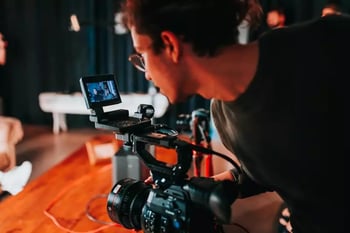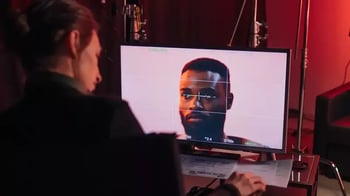10 Trends for Corporate Video Production in 2023
There are loads of exciting new trends that are shaping the way businesses approach corporate video production in 2023. Let's take a look at some of them.
Each year that passes, corporate video production undergoes significant changes, and some exciting trends have emerged that are shaping the way businesses approach video content. So, let's dive in and take a closer look at the most popular trends right now.
1. Short-form videos
First up, we have short-form videos. These are perfect for capturing viewers' attention quickly and delivering your business' message concisely. After all, we have zero attention spans these days.
As such, social media platforms like Instagram, TikTok, and LinkedIn are particularly popular places for these kinds of videos. They usually last anywhere from 15 to 90 seconds, so you can imagine how important it is to get your message across effectively in a short amount of time...
Salesforce knows this. Their "Customer Success" series is an ongoing series of short videos that feature interviews with small business owners and entrepreneurs, highlighting their journeys and the challenges they've faced.
Each video offers an inspiring and relatable look at the world of entrepreneurship. The series is a great example of how short-form video can be used to tell compelling stories and connect with your audiences on an emotional level.
2. Storytelling
Who doesn't love a good story? By incorporating storytelling into corporate videos, businesses can create a deeper connection with their audience and differentiate themselves from their competitors. It essentially helps businesses tell their brand's story and connect with their audience on an emotional level.
Take Four Seasons, the hotel and resort company, for example. They use storytelling to showcase the unique experiences guests can have at their properties. Their video, "A walk through History with Alexander Hamilton" allows viewers to follow a family as they experience all the delights the hotel has to offer while on their holiday.
3. Animation and Motion Graphics
Animation and motion graphics are also effective tools for corporate video production, especially when it comes to explaining complex ideas or data in a visually appealing way.
Slack, the software company, knows how to use animation to explain how its platform works. Their video, "What Is Slack?" uses animation and a lighthearted tone to explain how Slack can help teams communicate more effectively and increase productivity.
4. Authenticity and transparency
More and more companies are using corporate videos to showcase their authenticity and transparency, and this is another trend that is really taking off. Creating videos that offer a behind-the-scenes look at the company, its values, and its culture is a great way to build trust and credibility with the audience.
Patagonia, the clothing company, does this really well. This video features interviews with Patagonia employees and showcases the company's sustainable manufacturing practices.
5. Live-Streaming
Demand for live video content isn't going away after the pandemic, it's actually growing.
And while we seem to prefer video content in general, we engage at a much higher rate when the content is live.
For example, Facebook users watch live videos for 3x longer than pre-recorded videos, and live content generates 6x more interactions.
Another staggering 2022 statistic is that 71 million hours of content is viewed every day on live-streaming platform, Twitch, which began as a video game streaming service but has since expanded to appeal to a broader audience with more of a variety of live-streaming content.
Companies can use live streaming to connect with their audience in real-time, answer questions, and provide valuable insights.
6. USER-GENERATED CONTENT (UGC)
User Generated Content is on the up and up, and is a great way to build trust in your brand alongside your more branded video campaigns.
To add to this, TikTok sees the buying process as an infinite loop, not a marketing funnel. In other words, the buyer journey doesn't "end" with a purchase, it loops back on itself, with users posting about their purchase, offering feedback on products, and spreading awareness on their own profiles.
Following a purchase, one in four TikTok users has made a post about their new product, and one in five has made a tutorial video.
During the pandemic, destinations across Georgia came up with creative ways to help healthcare workers, first responders, employees, residents, and others hit hard by the coronavirus.
As a way to showcase their efforts and show stories of positivity and resilience, the DMO made a video using UGC photos and videos.
As destinations around the world reopen, videos showcasing real-time UGC show your audience how you are keeping people safe right now. They’re also good to repurpose across your social media channels.
7. BEHIND-THE-SCENES VIDEO CONTENT
We're a nosy lot, us humans. And our collective fascination with real people doing real stuff shows that.
This comes from a desire for authenticity in the brands we buy from, as well as the resurgence of DIY and crafting we all turned to throughout the pandemic. We seem to love watching people as they go about their daily lives and pursue their hobbies.
Offering a window into your brand's life, pursuits, and challenges through behind-the-scenes content gives viewers that AAA pass to your brand.
Formats such as outtakes, bloopers and extra footage that didn't make the final cut are a great way to give your viewers that peek behind the curtain.
8. ACCESSIBLE CREATIVE
Accessibility in corporate video is thankfully becoming more of a talking point recently, and rather than being a current "trend" per se, will constantly evolve and improve.
The idea behind accessibility in video marketing is to make sure that anyone, regardless of their disabilities, can engage with and enjoy video content. That's where elements like transcriptions, thoughtful colour use, and audio descriptions come in — they make it easier for everyone to understand and enjoy the content.
Take captioning in videos, for example. Not only does it help those with hearing impairments to follow along with the dialogue, but it's also helpful for anyone who wants to watch videos without sound - maybe while they're at work or in a public place. And let's not forget that it can also help people who speak different languages better understand your content.
In a nutshell, accessibility in video marketing is essential, and it's not just about ticking a box. It's about making sure that everyone has the same access to information and entertainment, regardless of who they are.
9. VIDEO SEO
Your website pages are probably already optimised for search engines, but did you know you need to optimise your video content as well? It's not a new concept, but it's becoming more of a mainstream practice to ensure that your video content can be easily found.
So how can you optimise your video for search engines? One tip is to include relevant keywords and phrases in your video's title, description, and tags. This will increase the likelihood of your video showing up in search results when people are searching for those specific keywords.
Another tip is to add a transcript of your video, which will not only make it more accessible to those who may have hearing impairments, but it'll also help with search engine optimisation as search engines can then crawl and index the text.
But it's not just about optimising keywords for search engines — you also need to create high-quality video content that people will want to watch and engage with. Because the longer people watch your video, the higher search engines will rank it as high-quality content, which means it could rank higher in search results.
By using relevant keywords and phrases, including transcripts, and creating high-quality content, businesses are increasing their chances of having their corporate video content found and watched by their target audience.
10. CONNECTED TV ADS
At the tail end of 2021, Forbes named CTV the fastest-growing video advertising platform. Netflix, Hulu, HBO Max, Disney Plus, and Amazon Prime are all examples of platforms that people subscribe to on their CTV devices, allowing viewers to watch what they want, whenever they want on their Apple TVs, Amazon Fire sticks, Playstations etc.
But here's where things get really interesting for marketers. These platforms are constantly gathering audience insights and capturing data in order to improve their algorithms for their viewers. This means they have access to a wealth of information about their audiences that can be used for targeted advertising.
As a marketer, this data allows you to reach small, highly-targeted audiences with personalized content. You can create ads that are specifically tailored to your audience's interests and preferences, and serve them up as viewers make their way through a TV series.
This means you can use sequential advertising to push viewers further down the marketing funnel and increase the chances of them taking the desired action, whether that's making a purchase or signing up for a service.
For example, Volvo used interactive CTV ads to showcase its new S90 model. They wanted to give viewers an immersive and interactive experience with the S90 model, and they did just that through Samsung and Roku streaming services.
Using CTV ads, viewers were able to explore both the interior and exterior of the car, getting a real feel for the features and design of the vehicle. But that's not all - the ads also included personalized messaging that directed viewers to the nearest Volvo dealership.
The result was an interactive experience that not only gave viewers a whole scope of the purchase journey but also felt more immediate, actionable and compelling. By using CTV ads, Volvo was able to give viewers a real taste of what it would be like to own the S90, and provided them with an easy way to take the next step in the purchase journey.
And the results speak for themselves - a 35% lift in sales! That's a pretty impressive result, and it just goes to show how effective CTV ads can be when used creatively and strategically.
So, if you're not already exploring the possibilities of CTV advertising, it's probably about time to start. With the wealth of data available, and the ability to target audiences with highly personalised content, it's a marketer's dream.
Just make sure to keep your content relevant, engaging, and aligned with your overall marketing strategy.
To sum up...
Corporate video production has undergone loads of changes in recent years, leading to a number of exciting trends that are shaping the way businesses approach Marketing's most sought-after content form in 2023.
These trends have helped businesses like yours differentiate themselves from their competitors, connect with their audiences on an emotional level, and build trust and credibility. And as video continues to play an important role in the way your business communicates, staying on top of what comes next is more important than ever.
Written by Jonathan English CEO for Venture Videos — a full-service video production agency that specialises in producing creative videos & campaigns that get real results.





















